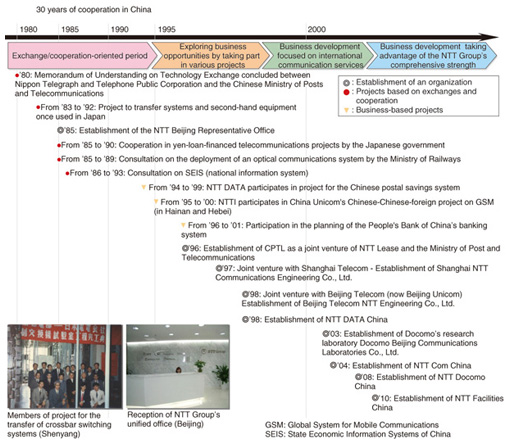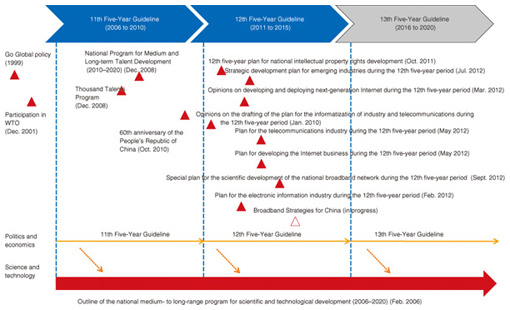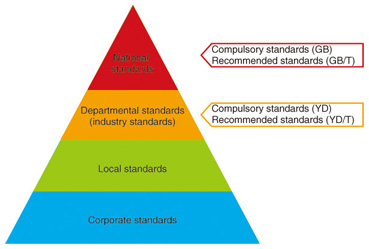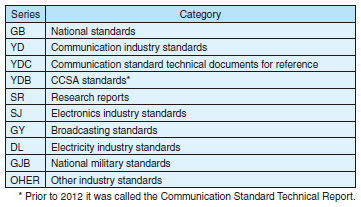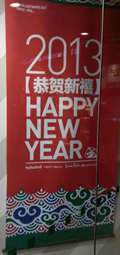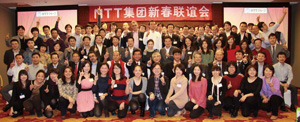 |
|||
|
|
|||
|
NTT around the World Vol. 11, No. 7, pp. 53–59, July 2013. https://doi.org/10.53829/ntr201307ov1  NTT Beijing Representative Office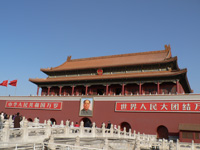 AbstractLocated in Beijing, China, the NTT Beijing Representative Office is the holding company's only Asian office outside of Japan, and it serves to support the global expansion of the NTT Group's business from an overseas viewpoint. This article describes how the NTT Beijing Representative Office supports the global implementation of research and development results in the course of its main activities, and outlines the latest trends of NTT Group business companies in China. 1. Introduction1.1 Overview of NTT Beijing Representative OfficeThe NTT Group’s relationship with China dates back over 30 years, and it has evolved in various ways since 1980, when the group was still known as Nippon Telegraph and Telephone Public Corporation (Dendenkosha). In 1980, Nippon Telegraph and Telephone Public Corporation and the Chinese Ministry of Posts and Telecommunications concluded a Memorandum of Understanding on Technology Exchange and implemented a project to transfer Japanese crossbar switching systems to China from 1983 to 1992. Soon after, in 1985, this transfer project led to the establishment of the NTT Beijing Representative Office, which has served as the NTT Group’s overseas base for the past 28 years. The Beijing Representative Office is controlled by its shareholder, Global Business Office (Fig. 1) and is one of the Group’s overseas offices alongside those in Washington, D.C. and San Jose, California. We explain in detail here how the Beijing Representative Office supports research and development (R&D) at NTT research laboratories through a number of activities.
1.2 Activities of Beijing Representative OfficeIn broad terms, the Beijing Representative Office’s support of R&D can be divided into two efforts: monitoring standardization in China and facilitating the overseas implementation of NTT research laboratory technologies. For the first effort, the Beijing Representative Office is participating with observer status in the standardization activities of the China Communications Standards Association (CCSA), which is the equivalent to Japan’s TTC (Telecommunication Technology Committee) and ARIB (Association of Radio Industries and Businesses) combined. Its main task is to collect information. By gathering information at the drafting stage of standardization, the Beijing Representative Office is able to quickly detect changes of direction in China’s information and communications technology (ICT) field, and to provide feedback to NTT research laboratories. The Beijing Representative Office is also taking part in TC10––the CCSA’s technical committee on ubiquitous network standardization–and is gathering information on the Internet of Things (IoT), which has attracted considerable attention in China in recent years. In terms of support for the overseas implementation of NTT research laboratory technologies, the Beijing Representative Office supports the introduction of laboratory technologies, and through technological communication between researchers, supports the development of products using laboratory technologies, mainly in Greater China. For example, NTT has concluded a Memorandum of Understanding with the China Academy of Telecommunication Research (CATR), a Chinese government-affiliated research institution; through the exchange of opinions on areas of mutual interest, cooperation toward international standardization (not exclusive to each other’s technologies) has become possible. The representative initiatives in China by the NTT Group are shown in Fig. 2. In the 1990s, the NTT Group’s involvement in China deepened further with its participation in projects for the Chinese postal savings system and the People’s Bank of China’s banking system. For example, China Union Pay is a Chinese debit card system commonly used in supermarkets and restaurants within the country, and the logo is becoming more common in Japan in electronic retail stores and major supermarkets. The company linking the China Union Pay system to the CAFIS (Credit and Finance Information System) system of Japanese banks is NTT DATA. It is probably fair to say that the NTT Group’s activities have played a role in making travel in Japan more convenient for Chinese tourists, who are subject to restrictions on the amount of foreign currency they can take out of China, and in boosting consumption.
2. Latest technological trends in ChinaChina’s ICT environment has evolved considerably in recent years. According to the Ministry of Industry and Information Technology, by the end of 2012, the number of mobile phone users had grown to about 1.11 billion, while there were about 175 million broadband users. About 80% of mobile phone users have a 2G contract, so 3G service has not yet been widely accepted. However, commercial services for TD-LTE (time-division Long Term Evolution)-based 3.9G mobile phones are expected to be launched by the end of this year. The transition to broadband is also advancing rapidly; in 2012, the number of broadband users increased by about 25 million, and the number of FTTH (fiber to the home) ports also increased by about 36 million in one year, for a total of about 260 million ports provided. The unique Chinese way of implementing instructions on directionality, which is conveyed through government policies, has played an important role in the evolution of China’s ICT. In China, the central government lays out its policies every five years, determining the areas in which industrial development will be focused on. The 12th Five-Year Guideline stipulates that the seven industrial fields to be focused on from 2011 to 2015 will be energy conservation and environmental protection, next-generation information technology (IT), biotechnology, production of cutting-edge equipment, new energies, new materials, and new-energy cars. The popularization of broadband is considered to be the focus in next-generation IT, and various measures to achieve this have been devised. In particular, national compulsory standard GB 50846-2012 (Code for design of communication engineering for FTTH in residential districts and residential buildings), enforced on April 1 of this year, stipulates in prefecture-level cities or larger (equivalent to Japanese cities) that offer FTTH, mandatory FTTH wiring for each household when new multi-unit apartments and residential buildings are constructed. The enforcement of this compulsory standard is expected to contribute to the further popularization of FTTH. As mentioned above, the central government sets key industrial fields in its Five-Year Guideline, and macro-development plans to achieve those goals are also sequentially announced. In response to these development plans, ministries, agencies, and local governments have also set numerical targets to be achieved by the end of the period of the 12th five-year plan (the end of 2015) as well as numerous guidelines and plans for conceptual attained levels. An outline of the representative policies and the various types of developmental plans is shown in Fig. 3.
3. Standardization activities in ChinaThe Beijing Representative Office is participating in the standardization activities carried out by the CCSA. The following is an explanation of standards in China. In accordance with the provisions of the Standardization Law of the People’s Republic of China (enforced in 1989), Chinese standards are divided into four categories: national standards, departmental standards (industry standards), local standards, and corporate standards (Fig. 4). Each of these standards is further divided into compulsory standards and optional standards (recommended standards). In standardization documents, compulsory national standards are indicated with GB followed by a number, while optional national standards are indicated as GB/T. Compulsory standards for the communication industry are identified with YD, while optional ones are shown as YD/T, thus allowing one to determine the role of each established standard based on its name. The categories of Chinese technological standards are listed in Table 1. It should be noted that the abbreviations here all indicate Chinese terms, so have not been defined.
The Beijing Representative Office is also participating in CCSA standardization efforts related to the Internet of Things (IoT). Mentioned as a national project in the 12th Five-Year Guideline, the IoT has been attracting considerable attention in China as a field of research and has generated significant activity including the establishment of university courses focusing on it. R&D of IoT and M2M (machine-to-machine) has also been progressing in Japan, and the possibility of applying it in the fields of power grids and transportation is being explored. However, China is characterized by the considerable expectations that are placed on investing in fields such as agriculture and ecology in addition to those above. 4. Latest business company trendsThe NTT Group’s business companies are currently expanding their operations in China, and when minor investments are included, their activities involve over 40 offices with more than 10,000 employees. Notable press releases made recently by business companies are listed in Table 2.
5. Future developments and challengesAs described before, the NTT Group has maintained a relationship with China in a variety of ways for the past 30 years. The relationship initially started for the purpose of providing technological cooperation and support, but it has gradually evolved to become more business-oriented with the establishment of offices and subsidiaries. While recent reports suggest that China’s growth is slowing down, the growth rate is said to remain high, and demand in the field of ICT is expected to keep increasing. We aim to earn the trust and appreciation of the people in China and other Asian countries, and while making efforts to achieve this, we intend to put the NTT Group’s cutting-edge ICT technologies and know-how to use in managing our business, and to contribute to the development of Asian countries and the popularization of Japan’s ICT technology. One issue that has been brought up is the improvement of the NTT brand name power within Asia. In Japan, NTT and the dynamic loop logo are well recognized; however, in Asia they are not necessarily recognized outside the circle of technicians. We will therefore work in the future to strengthen NTT’s brand name so as to ensure that each of our group companies can conduct their business smoothly. NTT Group unified office — short column
Christmas in China
As in the rest of the world, Christmas is an important event in China, too, but decorative illumination on the streets is not as common. However, Santa Claus costumes are very popular. Starting about two weeks before Christmas, the employees at many restaurants greet their customers with Santa hats on, and restaurants serving exclusively Chinese food are no exception. While such attire is common in China, I personally can’t help feeling that it’s somewhat out of place, as I fail to see the connection between Christmas—a Christian festivity—and Chinese food.
In China, the New Year means the lunisolar one rather than the one on January 1. For this reason, many of the Happy New Year signs that appear on the streets after Christmas often stay there until the Spring Festival instead of being removed soon after the New Year’s Day we celebrate on January 1. This year, the Spring Festival fell on February 9. The puzzling sight of Happy New Year signs well into January may be unique to China. Incidentally, a shoe store located in the basement of the Beijing Representative Office’s building had a Happy New Year sign up even at the end of March. It will be interesting to see when they finally take it down! Of China’s yearly festivities, the Spring Festival is the liveliest. People migrate throughout the country in large numbers. For 40 days around the Spring Festival, when chunyun (a special railway schedule to deal with the needs of passengers returning home for Spring Festival holidays) is in effect, the total number of passenger journeys across the country exceeds several times China’s population every year, with an estimate of 3.407 billion journeys this year. Also, it is customary to bring a variety of gifts when returning to one’s hometown, which greatly boosts sales before and after the Spring Festival. China has a similar custom to Japan’s tradition of giving New Year’s gifts. Here, it is called hongbao (red envelope). Traditionally, hongbao are given not only to small children, but also to parents or in-laws. Some people spend as much as a month’s income on hongbao alone. During the Spring Festival, the Chinese also hold year-end parties as we do in Japan. Many local companies hold lotteries with extravagant gifts such as smartphones, tablets, and microwave ovens as prizes to reward employees for their efforts in the course of the year.
Upon the completion of the NTT Group CSR* Report 2012––Our Initiatives in China, the Chinese arm of the NTT Group held the NTT Group Beijing Spring Party on February 1, 2013. It was a successful event attended by 94 employees from 14 NTT Group companies mainly in Beijing, which included NTT Communications, Dimension Data, NTT DOCOMO, NTT DATA, and NTT Facilities. The majority of the participants were Chinese employees. The event further helped foster a sense of unity within the Group, as the facilitation by the Master of Ceremonies and the speeches by each company’s representative were all conducted in Chinese.
Daisuke Ikegami, NTT Beijing Representative Office |
|||










